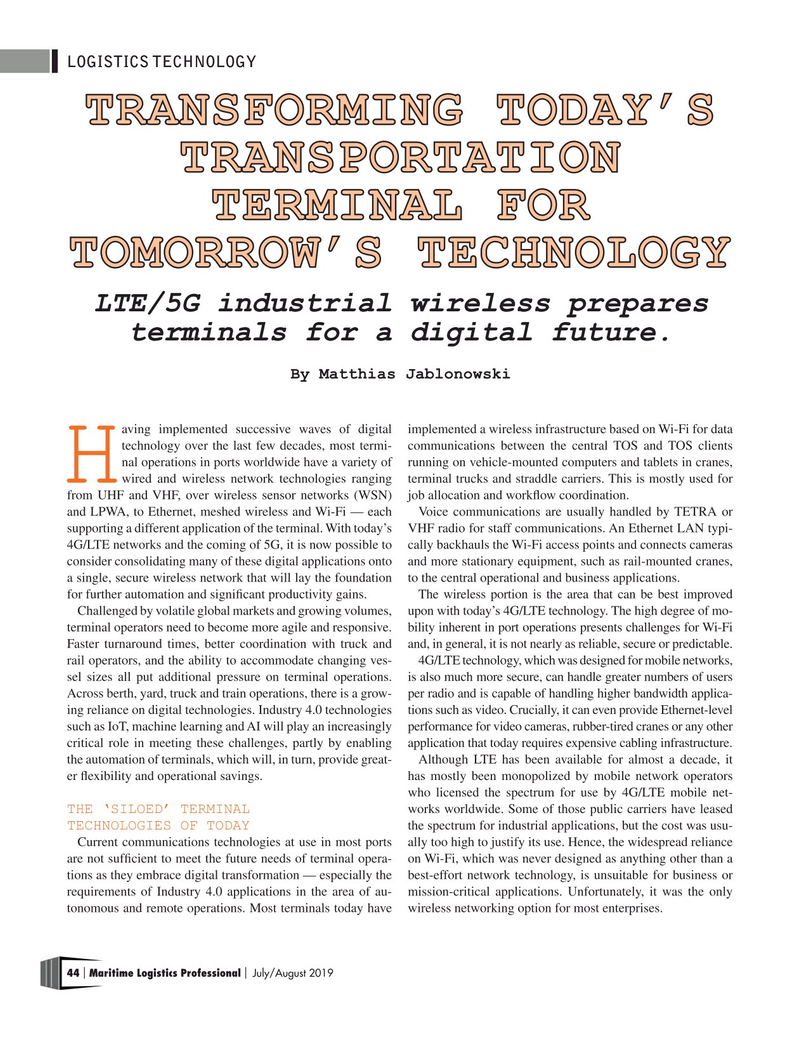
Page 44: of Maritime Logistics Professional Magazine (Jul/Aug 2019)
Breakbulk Issue
Read this page in Pdf, Flash or Html5 edition of Jul/Aug 2019 Maritime Logistics Professional Magazine
LOGISTICS TECHNOLOGY
TRANSFORMING TODAY’S
TRANSPORTATION
TERMINAL FOR
TOMORROW’S TECHNOLOGY
LTE/5G industrial wireless prepares terminals for a digital future.
By Matthias Jablonowski aving implemented successive waves of digital implemented a wireless infrastructure based on Wi-Fi for data technology over the last few decades, most termi- communications between the central TOS and TOS clients nal operations in ports worldwide have a variety of running on vehicle-mounted computers and tablets in cranes,
Hwired and wireless network technologies ranging terminal trucks and straddle carriers. This is mostly used for from UHF and VHF, over wireless sensor networks (WSN) job allocation and work? ow coordination.
and LPWA, to Ethernet, meshed wireless and Wi-Fi — each Voice communications are usually handled by TETRA or supporting a different application of the terminal. With today’s VHF radio for staff communications. An Ethernet LAN typi- 4G/LTE networks and the coming of 5G, it is now possible to cally backhauls the Wi-Fi access points and connects cameras consider consolidating many of these digital applications onto and more stationary equipment, such as rail-mounted cranes, a single, secure wireless network that will lay the foundation to the central operational and business applications.
for further automation and signi? cant productivity gains. The wireless portion is the area that can be best improved
Challenged by volatile global markets and growing volumes, upon with today’s 4G/LTE technology. The high degree of mo- terminal operators need to become more agile and responsive. bility inherent in port operations presents challenges for Wi-Fi
Faster turnaround times, better coordination with truck and and, in general, it is not nearly as reliable, secure or predictable. rail operators, and the ability to accommodate changing ves- 4G/LTE technology, which was designed for mobile networks, sel sizes all put additional pressure on terminal operations. is also much more secure, can handle greater numbers of users
Across berth, yard, truck and train operations, there is a grow- per radio and is capable of handling higher bandwidth applica- ing reliance on digital technologies. Industry 4.0 technologies tions such as video. Crucially, it can even provide Ethernet-level such as IoT, machine learning and AI will play an increasingly performance for video cameras, rubber-tired cranes or any other critical role in meeting these challenges, partly by enabling application that today requires expensive cabling infrastructure.
the automation of terminals, which will, in turn, provide great- Although LTE has been available for almost a decade, it er ? exibility and operational savings. has mostly been monopolized by mobile network operators who licensed the spectrum for use by 4G/LTE mobile net-
THE ‘SILOED’ TERMINAL works worldwide. Some of those public carriers have leased
TECHNOLOGIES OF TODAY the spectrum for industrial applications, but the cost was usu-
Current communications technologies at use in most ports ally too high to justify its use. Hence, the widespread reliance are not suf? cient to meet the future needs of terminal opera- on Wi-Fi, which was never designed as anything other than a tions as they embrace digital transformation — especially the best-effort network technology, is unsuitable for business or requirements of Industry 4.0 applications in the area of au- mission-critical applications. Unfortunately, it was the only tonomous and remote operations. Most terminals today have wireless networking option for most enterprises.
44 Maritime Logistics Professional July/August 2019 | |

 43
43

 45
45
